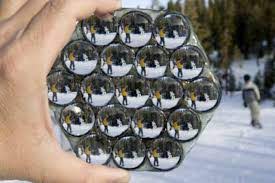Spinning Brains

Today’s class with Prashant Iyengar reminded me again why I find him so intriguing. Yes he is a philosopher, so it can sometimes feel like he is talking over your head or in circles. However, very often he knows exactly what might be getting in or going over and still wants to give you teasers and tastes of the enormous possibilities that exist within this vast, deep, and spiritual (Adhyatmik) experience of yoga. As he often has said “you will catch what you will catch”.
Prashant continued his thread from last weekend to clarify the “Mind-set addressals” that can be approached within the thought processes of asana. Along with this, he gave one of his “brain spinners”…
“Can you contemplate and find out when and how the mind is the container of thought and the thought the container of the mind? Both do occur. The thought process can occur under the mind and also over it.“
paraphrased Prashant Iyengar – July 2020
We might come to an asana with a state of mind that has thoughts contained within it. Or we might come to an asana thinking certain thoughts that then create a particular mind-set. These differing thought processes exist, and he urges us not to become “consumeristic” in our approach to yoga – only searching for the “final state” or “promised mind” of yoga written in any book. If you just want to immediately change your mind, you can take drugs, but it will not last and you will miss your whole journey.
“Yoga has to have a prismatic approach – an approach from numerous angles, views, schemes and paradigms. It is not an exact science that only looks at ’cause an effect’. Yoga is a philosophy that covers the cause and effect of science and then adds consequence to that.”
paraphrased Prashant Iyengar – July 2020
In all his teachings and writings, Prashant covers this prismatic approach to yoga which is why I have always found it odd that other folks view “Iyengar Yoga” as such a rigid subject. He referred to BKS Iyengar’s 85th Birthday celebration where he spoke of yoga mind-sets in asana according to the 4 asramas (the stages of life that include student, householder, retiree, and renunciate) and the 4 varnas (the caste groups that consist of teachers, warriors, merchants, or laborers). Prashant continues to remind us that paradigms and schemes of practice also exist within the chakras (energy centers), bandhas (energetic locks), mudras (sacred symbols), and mantra (sacred sound), just to name a few… But, these cannot be taken for granted and they HAVE to all occur within active and aware study under the “lab condition of asana”.
You cannot just read books, know terms, do postures, and study materials to experience yoga. The laboratory of asana must be used. “NO ECSTATIC DANCE!” in celebration of a supposed end. To get to the final knowledge and awareness of true yoga means ultimately being able to piece apart the difference in “the thought, the thinking, and the thinker”.
Tomorrow he promised to discuss “Breath-set addressal” which is how we may approach asana study through the manipulations and schemes of the breath. The breath and the mind are two sides of the same coin, so they work in accordance with each other in this fascinating laboratory of yoga. Until tomorrow…